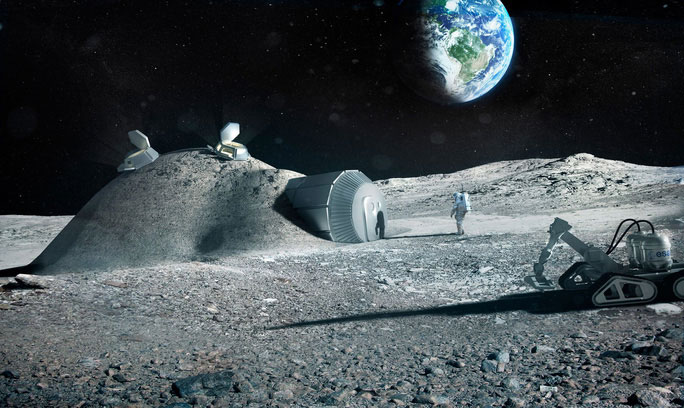Elsewhere in the Solar System there used to be 'armor of life' like Earth
Space rock samples brought back to Earth by NASA half a century ago reveal more surprises about the past of the object thought to be twice inhabited - the Moon.
Scientists have long believed that Earth's Moon, which is smaller than many of Jupiter's, Saturn's moons, etc., would not be large enough to have a magnetic field of its own. But lunar rock samples collected by other NASA Apollo astronauts 50 years ago prove otherwise.

Sketch of "Moon base"
The discovery, which is said to have puzzled scientists, has just been announced by researchers from Brown University in Rhode Island.
According to the Daily Mail, the analysis results show that these stones must have been formed in an environment with a strong magnetic field. It is Earth scientists themselves who still use paleomagnetic data in rocks to learn about the history of the Earth's magnetosphere, so the evidence from rocks is extremely reliable.
They suggest that the early Moon created itself a discontinuous but powerful magnetic field during its early geological activity - before turning into the solid rock mass it is today.
In that past, the Moon had a giant magma ocean like the Earth in the Great Fire. Inside that ocean, giant rocks sink through the liquid mantle, creating a magnetic field. This formed within the first 1 billion years.
This is an important discovery because the magnetosphere is considered to be the armor of each planet, a necessary condition for life on a celestial body to be protected if it is fortunate to be born. The magnetosphere created by Earth's powerful magnetic field is a necessary layer of "life armor" whose waning times are often associated with mass extinctions.
Previously, a study published in Astrobiology in 2018, authored by a team of astrobiologists from Washington State University (WSU-USA) and University of London (UK) showed that the Moon could have appeared. Early life form was twice as similar to Earth's cyanobacteria, but then became extinct.
- Discover more than 700 planets outside the solar system
- Surprise with a strange life on the new solar system discovered
- Are there more 'livable' planets than Earth?
- Life has spread throughout the solar system
- Discover the oldest solar system outside the solar system
- The discovery of 'super-Earth' can bring life near the solar system
- For the first time discovered something like 'armor of life' Earth in an exoplanet
- What is the distance from the Earth to the Sun?
- Stars that can create comet rain destroy the Earth
- NASA discovered more than 100 planets outside the Solar System
- The Solar System's water was born before the Sun.
- Video: Solar system flies in the universe at breakneck speed
 Van Allen's belt and evidence that the Apollo 11 mission to the Moon was myth
Van Allen's belt and evidence that the Apollo 11 mission to the Moon was myth The levels of civilization in the universe (Kardashev scale)
The levels of civilization in the universe (Kardashev scale) Today Mars, the sun and the Earth are aligned
Today Mars, the sun and the Earth are aligned The Amazon owner announced a secret plan to build a space base for thousands of people
The Amazon owner announced a secret plan to build a space base for thousands of people